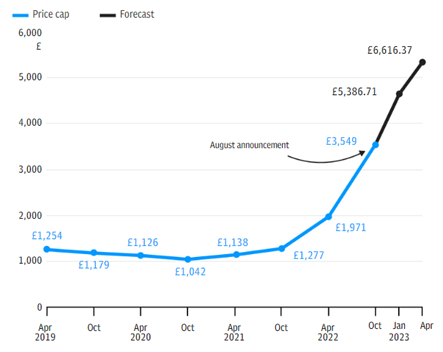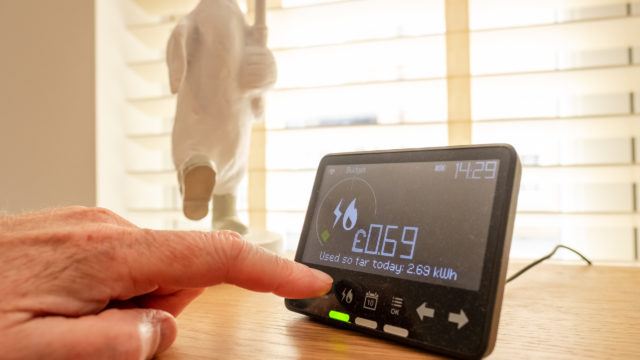02/09/22
One of the key drivers of soaring inflation and the cost of living crisis has been the sharp rise in energy bills.
Indeed, the Office for National Statistics say that the largest upward contributions to the annual inflation rate in July 2022 came from housing and household services – principally from electricity, gas and other fuels.
The rises have been so significant that, according to the Guardian, two-thirds of all UK households will be trapped in fuel poverty by January 2022 – defined as where energy costs exceed 10% of a household’s net income. The situation is even worse for some groups, with an estimated 86.4% of pensioner couples expected to fall into fuel poverty.
To help you understand the costs you and your loved ones might face over the next few months, here’s a useful explainer as to why energy prices are soaring, what you might pay over the next year, and what government support is available.
The price cap is based on the costs suppliers face, which have risen sharply
The energy price cap is designed to protect you from short-term price changes. It reflects what it costs to supply energy to your home by setting a maximum amount suppliers can charge for each unit of energy and caps the level of profits an energy supplier can make.
The main component of the cap is the cost of wholesale energy – what energy suppliers pay for gas and electricity. Energy prices have risen sharply because demand for gas increased when Covid-19 lockdown restrictions eased, and because the war in Ukraine has threatened supplies from Russia.
Metro reports that the cost of a therm of gas to commercial buyers rose by £1 in just the fortnight to 17 August 2022, while electricity prices rose by £100 per megawatt hour in the same period.
In addition, the cap covers things like the cost of supply and maintaining energy infrastructure. There’s also what’s known as an “adjustment allowance” which allows Ofgem to factor any unexpected costs into the price.
As an example, from April 2022, Ofgem added the costs resulting from all of the suppliers that have failed in recent months to the price cap. About £68 of the typical £1,971 a year bill under the April 2022 price cap is for supplier failures.
You may recently have read that the price cap will now be reviewed every three months, rather than six months as before. Ofgem say this makes it less likely that more energy suppliers will collapse.
The price cap will rise in October 2022
Last summer, the energy price cap was £1,138 a year.
In April 2022, Ofgem increased the energy price cap by 54% to £1,971 and, in October, the cap will rise to an eye-watering £3,549. Remember that the cap is based on a household with “typical consumption” on a dual electricity and gas bill paying by direct debit.
Then, the price cap will change in January, April, July, and October 2023. Experts predict further sharp rises in the price cap in spring and summer 2023, as the chart below shows.

Source: the Telegraph
The new cap means:
- The daily electricity standing charge has risen from 45.3p to 46.3p
- The electricity unit rate (kWH) has risen from 28.3p to 51.8p
- The daily gas standing charge has risen from 27.2p to 28.4p
- The gas unit rate (kWh) has risen from 7.4p to 14.8p
The current £1,971-a-year cap equates to an average monthly direct debit of £164.25, while the new cap, from October 2022, increases that figure to £295.75 a month. In August 2021, the Guardian report that the average monthly direct debit was just under £95.
One crucial point to remember is that the price cap is not the maximum that you can be charged.
The price cap sets a limit on the rates you pay for each unit of gas and electricity and reflects typical energy usage levels. Ofgem says the price cap is “not a cap on the maximum bill a household can be charged, which is based on their usage”. If you use more energy, you will pay a higher bill.
On 24 November 2022 you will find out what the cap will be for the key winter period from 1 January to 31 March 2023.
Every household will receive government help towards their bills
To help you to meet the rising cost of energy, the government has announced that all households in England, Wales and Scotland will receive a one-off £400 discount on their fuel bills in October. The government says customers in Northern Ireland will also get the money.
This £400 discount will be applied in monthly instalments over six months:
- You will receive a reduction of £66 on your bills in October and November
- You will receive a reduction of £67 on your bills from December 2022 to March 2023.
If you pay by direct debit or direct credit the money will be credited to your energy account. If you have a pre-payment meter you will have the money applied to your meter, or it will be paid through a voucher.
In addition, more than 8 million low-income households who receive Universal Credit, tax credits, pension credit and other means-tested benefits will receive a £650 payment.
Disabled people will also receive £150 (plus the £650 payment if they also qualify for that).
Finally, pensioner households who receive the winter fuel payment will receive £300.
Of course, with the issue becoming highly politicised in recent weeks, it is possible that further announcements regarding support packages may be made by the new prime minister in due course.
Get in touch
Financial planning can help you to establish a budget and to ensure you remain on track to reach your goals, whatever happens in the wider economy.
To find out how we can help, please get in touch. Email info@depledgeswm.com or call 0161 8080200.
Please note
This blog is for general information only and does not constitute advice. The information is aimed at retail clients only.

Comments on Explained: the energy price cap and how it affects you
There are 0 comments on Explained: the energy price cap and how it affects you